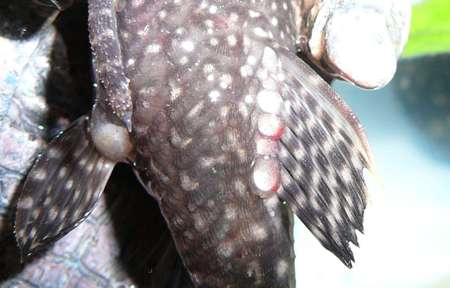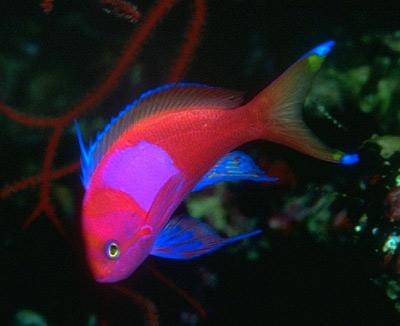
Многие проблемы со здоровьем и заболевания возникают у рыб в результате стресса, низкого качества воды, перенаселенности аквариумов и отсутствия карантина для новых или больных рыб. Но все негативные факторы можно устранить с помощью надлежащего ухода и гигиены. Ниже мы расскажем о сердечно-сосудистых заболеваниях, которые встречаются и у рыб.
Газово-пузырьковая болезнь
 Рыбы относятся к холоднокровным животным. Это означает, что температура их тела напрямую зависит от температуры окружающей среды и колеблется вместе с ней. В целом можно смело утверждать, что температура воды напрямую влияет на все физиологические процессы у рыб. Если вода очень холодная или находилась под высоким давлением, она обычно очень насыщена растворенными в ней газами.
Рыбы относятся к холоднокровным животным. Это означает, что температура их тела напрямую зависит от температуры окружающей среды и колеблется вместе с ней. В целом можно смело утверждать, что температура воды напрямую влияет на все физиологические процессы у рыб. Если вода очень холодная или находилась под высоким давлением, она обычно очень насыщена растворенными в ней газами.
Если температура воды повышается или давление резко падает, эти газы быстро расширяются. Если рыба уже находится в этой воде в течение какого-то времени, газы, поглощенные ею в процессе дыхания, также быстро расширяются и поступают в кровоток. Такое состояние называется газово-пузырьковой болезнью рыб. Образующиеся небольшие пузырьки могут привести к массивным повреждениям тканей и гибели рыбы. У рыб, живущих в декоративном пруду, может начаться газово-пузырьковая болезнь, если хозяева наливают в водоем колодезную воду из шланга. Если шланг погружен в колодец, растворенные газы останутся в воде и могут вызвать проблемы у рыб. Это особенно часто встречается там, где вода поступает из глубоких колодцев. Чтобы предотвратить это, следует дать воде отстояться, или же наливать воду так, чтобы она разбрызгивалась, попадая в аквариум или пруд.
Избыток аммиака
Избыток аммиака в воде крайне вреден для рыб. Он может возникнуть в аквариуме по разным причинам.
Высокий уровень аммиака в аквариуме характерен для двух синдромов. Первый называется «синдромом нового аквариума». В этом случае концентрация аммиака вызвана тем, что в аквариум заселяют новых рыб до того, как система биологической фильтрации заработает на полную мощность.Обычно это происходит в течение 1-3 недель после наполнения нового аквариума водой. Аммиак накапливается, поскольку в биофильтре недостаточно бактерий, чтобы переработать его. В данной ситуации необходимо ежедневно проверять воду с помощью тестеров. Если уровень аммиака достигает 2 мг на литр воды и выше, необходимо заменить как минимум 50% воды в аквариуме. Но подобные частые проверки будут необходимы лишь в течение 1-2 недель (если в системе нет других проблем). По мере роста колоний бактерий тесты будут показывать снижение уровня аммиака и рост нитритов. Процесс можно считать завершенным, когда уровень нитритов также нормализуется.
Второй тип проблемы, возникающей из-за аммиака, называется «синдромом старого аквариума». Для нее тоже характерна высокая концентрация аммиака, но суть проблемы совершенно иная. Она проявляется неожиданным и резким падением уровня кислотности воды (pH), часто до значений ниже 6.0, в результате чего бактерии в биофильтре погибают. Следствием гибели бактерий, в свою очередь, является высокая концентрация аммиака – но в данном случае это лишь следствие проблемы. Простой замены воды может быть недостаточно, так как увеличение кислотности может привести к тому, что аммиак станет ядовитым и отравит рыб.
«Синдром старого аквариума» возникает из-за снижения буферной емкости, что приводит к изменениям кислотности. Это может быть вызвано неправильной заменой воды. Типичная ошибка начинающих аквариумистов: они доливают воду в аквариум взамен испарившейся, но не сливают старую воду. Слив старой воды – важная часть процесса смены воды. Если этого не происходит, в аквариуме скапливаются органические кислоты, которые производятся рыбами и бактериями, находящимися в вашей водной системе. Если старую воду не сливать, кислоты уничтожают буферную емкость воды (измеряемую общим уровнем щелочи). Когда уровень щелочи падает до нуля, поднимается кислотность, погибает биофильтр и возникает «синдром старого аквариума».
Чаще всего в аквариуме с «синдромом старого водоема» наблюдается высокая концентрация аммиака (иногда выше 10 мг на литр воды), небольшое количество или полное отсутствие щелочи, низкий уровень кислотности (ниже 6.0), и высокая степень жесткости воды (несколько сотен миллиграмм на литр). Если ситуация в вашем аквариуме именно такова, рыбу надо пересадить в другой временный аквариум. Старый аквариум необходимо полностью разобрать, тщательно промыть (включая биофильтр), и обновить все систему. Поскольку эта система будет совершенно новой, без устоявшегося биофильтра, необходимо наблюдать за уровнем аммиака и менять воду по мере его повышения до тех пор, пока система фильтрации не наладится.
 Анемия
Анемия
Анемией называется состояние, когда количество красных кровяных телец снижено по отношению к норме. Первый признак анемии у рыб – очень бледные жабры. Наблюдательный владелец, возможно, заметит это. Причин у анемии может быть несколько: различные инфекции, недостаток фолиевой кислоты, длительное повышение уровня нитритов в воде… Если вы подозреваете, что у ваших рыб анемия, необходимо посоветоваться с профессиональным ветеринаром.
Чтобы оставить здесь комментарий, войдите или зарегистрируйтесь на сайте.
Авторизация